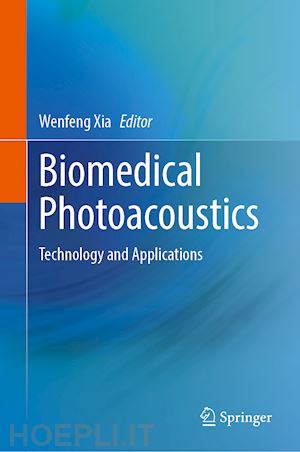
Questo prodotto usufruisce delle SPEDIZIONI GRATIS
selezionando l'opzione Corriere Veloce in fase di ordine.
Pagabile anche con Carta della cultura giovani e del merito, 18App Bonus Cultura e Carta del Docente
Photoacoustic imaging (also called optoacoustic imaging) is a hybrid modality based on the generation and detection of ultrasound in response to optical absorption of tissue. It combines advantages from both optical and ultrasound imaging, providing functional, molecular and microstructural information of tissue at scalable spatial resolution and depth. This technology has undergone exponential growth over the last two decades, and it is now widely viewed as one of the most exciting biomedical imaging modalities.
This book introduces the technology and applications with chapters written by leading international research groups. It will be of interest to a wide range of audiences, including postgraduate students and researchers in physics and engineering as well as biomedical and clinical sciences.
Chapters 8, 16, 17 and 21 are available open access under a Creative Commons Attribution 4.0 International License via link.springer.com.
Principles of photoacoustic imaging.- Principles and applications of multi-scale photoacoustic microscopy.- Principles and applications of photoacoustic tomography.- Handheld probes for photoacoustic and ultrasound imaging.- Principles and applications of photoacoustic endoscopy.- Wavefront shaping-assisted photoacoustic imaging.- Nanocomposite materials for all-optical photoacoustic and ultrasound imaging.- X-ray induced acoustic imaging.- Multimodal optical and photoacoustic imaging.- Photoacoustic image reconstruction.- Quantitative photoacoustic imaging.- Deep learning enhanced photoacoustic image reconstruction.- Deep learning in quantitative photoacoustic imaging.- Contrast agent for photoacoustic imaging.- Technical validation of photoacoustic imaging systems using phantoms.- Pre-clinical photoacoustic imaging of tumor stroma and liver fibrosis.- Photoacoustic imaging in pre-clinical cancer research.- Photoacoustic spectrum analysis.- Photoacoustic mesoscopy for melanoma microvascualture imaging in vivo.- High-resolution in vivo photoacoustic imaging based on a Fabry-Perot scanner.- Photoacoustic neuroimaging.- Intravascular photoacoustic imaging: instrumentation and applications.- Photoacoustic breast imaging.- Photoacoustic imaging of interventional medical devices.- Preclinical and clinical applications of LED-based photoacoustic imaging.
Dr. Wenfeng Xiais a Senior Lecturer in the School of Biomedical Engineering & Imaging Sciencesat King’s College London. He received a BSc in Electrical Engineering from Shanghai Jiao Tong University, China, and a MSc in Medical Physics from University of Heidelberg, Germany, in 2005 and 2007, respectively. In 2013, he obtained his Ph.D from University of Twente, Netherlands. From 2014 to 2018, he was a Research Associate / Senior Research Associate in the Department ofMedical Physics and Biomedical Engineering at University College London, UK. He joined King’s College London in 2018 and immediatelyfunded thePhotons+ Ultrasound Research Laboratory (PURL), which brings together talented scientists who are committed to transform the ways that surgical and interventional procedures are performed via ground-breaking technological innovations. They are fascinated by howlight and sound interact with biological tissue, and how these interactions can be used for patient benefits. In particular, the research at PURL iscentered on the technological advancements and clinical translation ofphotoacoustics (also calledoptoacoustics), an emerging imaging and sensing technique that is based on light generated ultrasound.











Il sito utilizza cookie ed altri strumenti di tracciamento che raccolgono informazioni dal dispositivo dell’utente. Oltre ai cookie tecnici ed analitici aggregati, strettamente necessari per il funzionamento di questo sito web, previo consenso dell’utente possono essere installati cookie di profilazione e marketing e cookie dei social media. Cliccando su “Accetto tutti i cookie” saranno attivate tutte le categorie di cookie. Per accettare solo deterninate categorie di cookie, cliccare invece su “Impostazioni cookie”. Chiudendo il banner o continuando a navigare saranno installati solo cookie tecnici. Per maggiori dettagli, consultare la Cookie Policy.